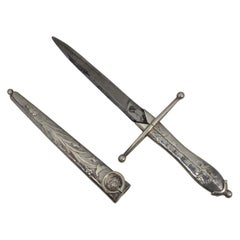Victorian Novelty Dagger
Recent Sales
Antique 19th Century British Early Victorian More Silver, Flatware and S...
A Close Look at Early-victorian Jewelry
Also called Romantic period jewelry, antique early Victorian jewelry and watches were a celebration of the young monarch’s love.
When Prince Albert became engaged to Queen Victoria, he gave her a serpent ring with emerald eyes, her birthstone. While this may seem a bit simple for our contemporary tastes, the serpent symbolizes eternity, and has become a popular motif in jewelry. The tail in the serpent’s mouth forms an unbroken circle. This dewy-eyed happiness trickled down to the masses and men and women favored jewelry that was sentimental and full of symbolism. Today, antique Victorian jewelry is very coveted and highly collectible.
Romantic period jewelry tends to be feminine and ornate. Flowers, hearts, birds, and bows were just some of the common decorative motifs. These pieces were embellished with seed pearls, coral and turquoise. It was common to express your devotion with jewelry — REGARD and DEAREST rings were particularly popular. These rings were set with stones that corresponded to each letter: Ruby, Emerald, Garnet, Amethyst, Ruby, Diamond.
Most often, the design of the ring was simple, with the stones going across the shank of the ring in a line, but it was not uncommon to see a REGARD ring in a flower formation, with each stone set in the petal of the flower.
Another common early Victorian ring style was two hands clasping a flower or stone. They came in many styles and were made of coral and ivory but also of gold with precious and semiprecious gemstones. These rings, while not exclusively Victorian, are often associated with the time period and symbolized friendship. Lockets enclosed with hair, cameos depicting cupid or a loved one’s face and enamel pieces were also popular.
The early Victorian period corresponded with the beginning of the Industrial Revolution. Jewelry, no longer made only by hand, became more affordable during the 19th century. The growing middle class also helped increase the demand for it. This was reflected in how women styled their jewelry; they were not afraid to adorn themselves from head to toe with stacking and layering in between. Considering the time period (this was before the California Gold Rush), a lot of pieces in the Romantic period were made using low-karat gold or were gold-plated. Fine gold wire was also employed frequently to add to the design. This is a nice trick to know when determining the date of Victorian jewelry.
Find a range of antique Romantic period brooches, necklaces, bracelets and other jewelry on 1stDibs.
Finding the Right Silver-flatware-silverplate for You
While early utensils were often shaped from clay, wood or bone, silversmiths later crafted flatware from precious metal. In the 19th century, mass production of electroplated flatware made silver utensils accessible to the middle class. Now, antique and vintage silver, flatware and silver-plate objects for dining and the home are heritage pieces reflecting this history of design.
Silver spoons were so prized in 15th-century England that people would travel with the valuable utensils. Forks in the 17th century were frequently made with steel and likewise only available to the upper class. Silver flatware continued to be produced in small workshops in the 18th century and was a luxury reserved for the elite. When George I came to the throne in 1714, the silver dining service — including plates, dishes, soup tureens, chargers and sauceboats — became all-important.
Innovative manufacturing techniques such as the electroplating process in the 19th century would transform silversmithing with industrialization. Sheffield plate was used from 1750 to 1880 and involved a fusion method to fabricate everything from knife handles to serveware. French industrial chemist Henri de Ruolz discovered a gilding and silver-plating process for metals in 1841, with the silver-like results so celebrated that Napoleon III ordered a 3,000-piece flatware set. The expansion of table service in the Victorian era also led to an increasing number of flatware and serving pieces in a canteen, or cutlery chest, all with specific uses, from toast forks to butter picks.
While affordable metal flatware is widely available today, historic brands including Gorham Manufacturing Company — whose legendary contribution to the history of silver making started in 1831 — and Christofle continue the tradition of silver and silver-plate flatware.
Browse 1stDibs for both antique and contemporary silver, flatware and silver-plate objects in a range of elegant designs to enhance your dining table.
